This blog challenge is to stimulate my own genealogy blogging efforts in 2014 by focusing on a different kind of genealogical record each week. I wanted a challenge that reflected my own archival background as well as my own genealogy interests and there are probably lots of other records that I could have included. The challenge has an Australian focus but most of these records will be found just about anywhere in the genealogy world.
The 52 different types of genealogical records I finally decided on are listed in no particular order (each week will be a random surprise). Originally I planned to do this over 52 weeks but I now realise that I have to factor in travel and illness so it will continue a little bit over a year. Anyone is welcome to do all or part of this blogging challenge. Let me know if you are participating and I will put a link to your post under each week’s challenge.
So far I know of six bloggers who are taking up the challenge from time to time and I have put links to their individual entries at the end of each week’s blog if they have submitted something for that week. Thanks Judy Webster, Sharn White, Cassmob, Anne, Campaspe Library and Sharon for participating and encouraging me to keep up the blog challenge myself!
Also participating in this blog challenge:
Links to Week 1 Military Medals Week 2 Internal Migration Week 3 Probates (wills and administrations) Week 4 Memorial Cards Week 5 Family Stories Week 6 Land Records Week 7 Local Histories Week 8 Diaries Week 9 Inquest Records Week 10Occupation Records Week 11 Newspapers Week 12 Gazetteers Week 13 Personal Names and Surnames Week 14 Cemetery Records Week 15 Civil Registration and Certificates Week 16 Naturalization and Citizenship Records Week 17 Court Records Week 18 Almanacs Week 19 Family Bibles Week 20 Mining Records Week 21 Obituaries Week 22 Family Letters and Correspondence Week 23 Electoral Rolls Week 24 Post Office Directories
Week 25 Emigration & Immigration Records
Everyone wants to know the name of the ship/s their immigrant ancestors came out on. I have managed to track down all of mine except for one great great grandmother Elizabeth Rosewarne who I believe arrived in South Australia.
The first thing when looking for an arrival is to establish which colony/state they arrived in and death certificates can often provide a clue.
Two of my ancestors James Henry Trevaskis and the missing Elizabeth Rosewarne arrived in South Australia (separately and later married). After a few years they moved to Queensland which was quite a distance back in the 1860s.
Another two ancestors Thomas and Elizabeth Price arrived in Sydney, moved around southern New South Wales for a few years before heading up to Charters Towers. As they had a child every couple of years over a 20 year period, I was able to trace their movements through New South Wales and Queensland in some detail by purchasing all the birth certificates.
One of my mining families (Henry and Georgiana Bullen) started off in Sydney before heading to the Victorian gold fields in the 1850s and then heading up to the Gympie gold fields in the 1870s and some of their grandchildren even followed the gold to Western Australia in the 1890s. So our ancestors moved around.
Once you know the colony/state of arrival, check out the relevant State Archives or the National Archives of Australia post 1901 as quite a lot of passenger lists have now been indexed and are freely available online. Some States like Queensland and New South Wales have direct links to digitised copies of the passenger lists which is fantastic. You can quickly see if it might be the right person or not.
The information on a passenger list can vary with some only give a name, age, marital status, country of origin, and perhaps an occupation. Some earlier lists are more informative and may even indicate if the new arrivals had relatives in the colony already. While the main series of passenger lists may have been indexed, there may still be other passenger records that are not indexed or not digitised and online so it is always necessary to check further with the relevant State Archives or the National Archives of Australia.
If they did not come out under an emigration scheme, they may have been listed as steerage passengers, with no name or other details recorded. In this case it may be very hard to identify the ship of arrival unless it is mentioned in an obituary, correspondence or a diary. Sometimes the name of the ship can turn up in unexpected places. Another ancestor, John Carnegie spend three months in prison which was good news for me as the prison record gave the name of the ship which then led me to the passenger list.
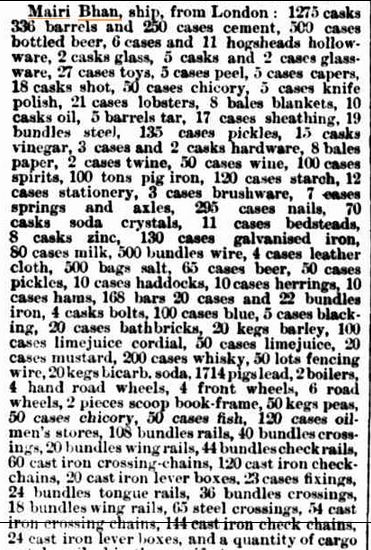 Newspapers also recorded the names of some shipping passengers especially on coastal trips or even across to New Zealand and back. So it may be useful to check in Trove but remember they could be listed as Mr and Mrs Smith, no given names or perhaps just an initial.
Newspapers also recorded the names of some shipping passengers especially on coastal trips or even across to New Zealand and back. So it may be useful to check in Trove but remember they could be listed as Mr and Mrs Smith, no given names or perhaps just an initial.
As well as discovering the name of the ship I also like to check for a photograph of the ship and that is where Trove (Pictures, Photos, Objects) can be quite useful. A Google Images search may also be worthwhile.
Although it may sound a little odd, I also like to check and see what cargo the ship was bringing out. John and Sarah Finn came out on the Mairi Bhan and arrived in Brisbane in November 1882. The image from Trove shows the cargo on board and a search on the name of the ship will bring up a number of references to the ship’s arrival, cargo and often reports on the voyage out. All good background material for the family history.
I will keep looking for my ancestor who ‘swam’ in any new indexes or resources. I also go back and add to my knowledge of all the other arrivals by reviewing new resources from time to time. Is it time to review your ancestor’s arrival?
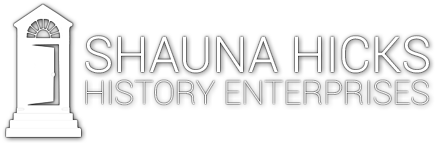
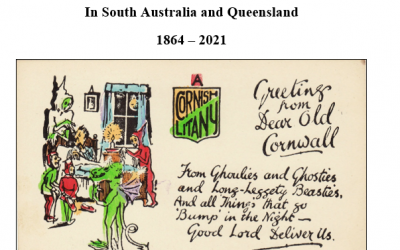

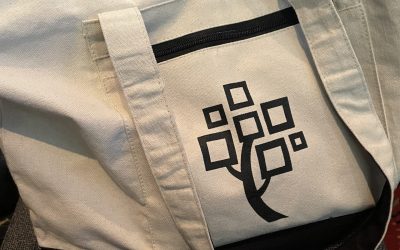
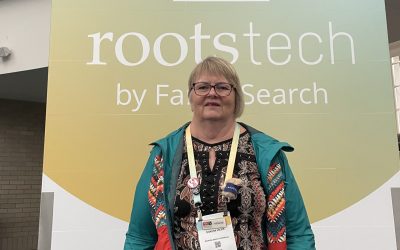
I agree that the ship’s cargo is interesting, and I’ve always made a note of that. As for the people who ‘swam’…. When Inside History published my article about passengers who used a false identity to emigrate to Australia, there was an exciting result (Genealogy Serendipity and the False Identity Story).
Thanks Judy nice to know someone also likes cargo and a good reminder never to give up looking. Lots of reasons why we might not find someone then the big breakthrough!
Hi Shauna, this is a really interesting post! I started researching my family history at the end of last year, and have just about traced it back as far as I can within Australia. My next step is to start looking at how my ancestors arrived, so this is a timely post! Thanks for sharing your experiences!
If you find information about the ship and it cargo, how do you document that? Do you link these sources into your family tree, or do you keep a separate file with this sort of additional information?
Hi Derek I have separate Word documents for all my families where I include all that additional information – a sort of draft family history in the making. One day I will say that is the end and publish although along the way I have given copies to various family members as it is a great way to quickly share all of that info. Keeping everything up to date is the issue especially if I find lots of info on a number of families in any new resources.
I was interested to stumble across your blog. My maternal great grand father Edward (Ed) Loonam was on the Mairi Bhan with your ancestors. He was 24yrs old and ultimately settled in Sydney. I still have a copy of the his original ticket, which outlines the rations they were given in steerage.
Hi Frances thanks for making contact. Wow, you still have his original ticket, what a fantastic heirloom. I often wonder what happened to the other people travelling with them on the ship so it is good to hear from another descendant.